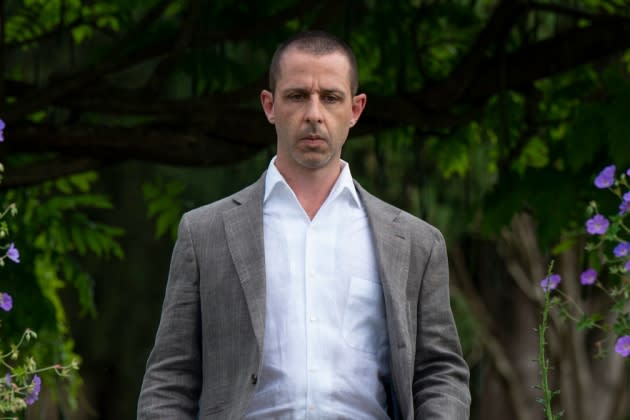Method or Madness: Jeremy Strong and Brian Cox’s ‘Succession’ Drama Represents a Larger Clash of Acting Styles
- Oops!Something went wrong.Please try again later.
- Oops!Something went wrong.Please try again later.
- Oops!Something went wrong.Please try again later.

“Method acting” long ago lost its meaning.
Instead, it’s become a catchall to describe an intense commitment to getting it right on stage or screen. It’s an all-out approach that sees performers pack and shed pounds, feast on live cockroaches or raw bison, extract teeth or eschew showers, and remain in character between takes. Those are just a few examples of the extremes to which Robert De Niro, Christian Bale, Nicolas Cage, Leonardo DiCaprio, Shia LaBeouf, Charlize Theron, Daniel Day-Lewis and their ilk push themselves in the service of their art. For their suffering, they receive Oscars and Emmys, along with a ton of media coverage — just look at the scores of pieces documenting the gonzo things Jared Leto has done each time one of his movies get released.
More from Variety
'Succession': Laura Ingraham and Tomi Lahren Inspired Kerry's Awkward News Anchor Video
5 Designer Tote Bags That Wouldn't Get You Kicked Out of Logan Roy's Birthday Party
'Succession' Season 4 Premieres to Record 2.3 Million Viewers, Beats Previous Series High by 33%
The payoff can be electrifying performances that blur the lines between character and actor. But it’s an approach that can be deeply annoying to the people around its practitioners, particularly actors schooled in less all-consuming methods of deploying their craft. The latest thespian dust-up went down on the set of “Succession,” where Jeremy Strong’s Day-Lewis-ian effort to fully capture the spirit of the troubled corporate scion he plays on the show involved isolating himself from his fellow performers, showing up to work tipsy, and in one scene, jumping off a stage with such abandon that he hurt his tibia.
Strong’s shenanigans didn’t sit well with his co-star Brian Cox, a veteran actor who honed his instrument playing eight shows a week for the Royal Shakespeare Company and the Royal National Theatre. Cox labeled Strong’s style “fucking annoying” in one interview and later vented his displeasure to Variety: “I’m sorry. All that sort of ‘I think, therefore I feel.’ Just do the job. Don’t identify.”
Cox isn’t alone. Anthony Hopkins decried Method acting as “a pain in the ass,” Mads Mikkelsen called it “bullshit,” and Toni Collette dismissed it as “utter wankery.” In an oft-repeated anecdote, Laurence Olivier was so exasperated by Dustin Hoffman’s decision to stay up all night to look exhausted for a scene in “Marathon Man” that he tartly asked, “My dear boy, why don’t you just try acting?” Hoffman later claimed Olivier was joking, but the point is it sounds like something Olivier would say. Yet what’s curious is that many performers linked with Method acting don’t identify as Method actors. Strong, for instance, says he practices “identity diffusion.” Whatever they call themselves, Cox and Strong’s work in “Succession” is extraordinary, and any off-screen tension only enhances their performances as a clashing father and son.
So what is the Method? Russian director Konstantin Stanislavski developed the approach in the early 20th century, creating a “system” that encouraged actors to do things such as draw on their memories when playing roles. However, “The Method: How the Twentieth Century Learned to Act,” Isaac Butler’s definitive history, argues that Stanislavski’s practices weren’t just passed down like commandments. They were fiercely debated and reinterpreted by subsequent teachers, such as Stella Adler and Lee Strasberg, who pushed their students, often in radically divergent ways, to collapse the boundaries between their own lives and those of the characters they inhabited. That ushered in generations of galvanic screen actors, from Marlon Brando and Montgomery Clift to Hoffman and De Niro. These were artists intent on pushing themselves to the limit. They needed every tool at their disposal. But maybe there’s more to it than perfectionism.
“Acting is such a tenuous thing,” Brando once confessed in an interview for The New Yorker, going on to describe it as “a fragile, shy thing.” And it’s easy to see what he meant, because it is such an ephemeral art form. Success or failure depends on the vagaries of taste, scoring a few good breaks while steering clear of the bad ones, and riding a wave that threatens to crash in a cacophony of bruising reviews or box office bombs. Given that uncertainty, it makes sense that actors would want to find some way to exert control. Even if they drive everyone around them crazy.
Best of Variety
Sign up for Variety’s Newsletter. For the latest news, follow us on Facebook, Twitter, and Instagram.
